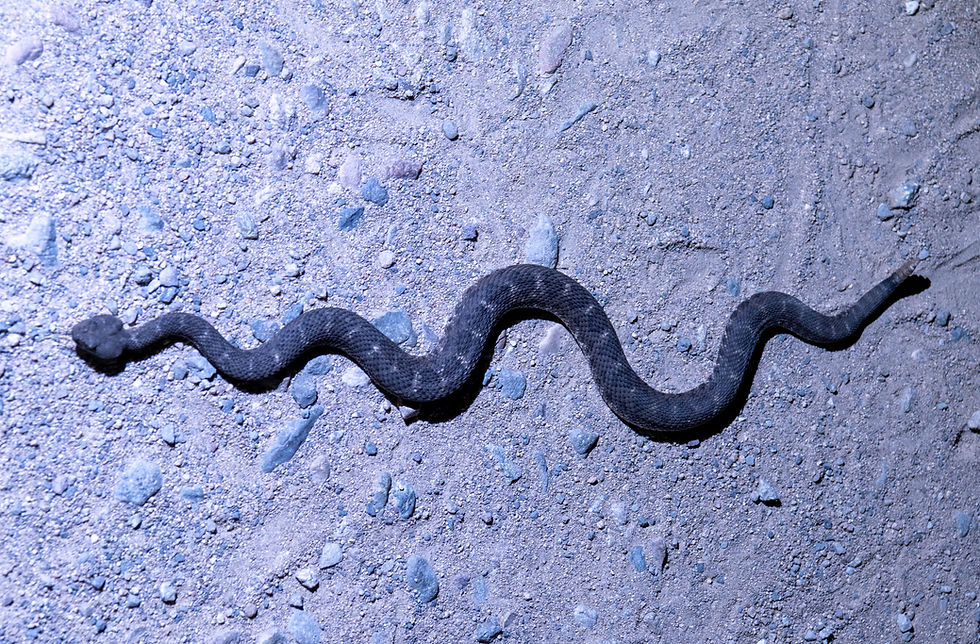Southwestern Speckled Rattlesnake
Crotalus pyrrhus

The Southwestern Speckled Rattlesnake (Crotalus pyrrhus) is a medium to large venomous pit viper, reaching lengths of up to 1,295 mm (51 inches). Its coloration is highly variable, typically harmonizing with the environment. Shades range from rusty tan, pinkish-brown, and peach to off-white, pale gray, and even blue-gray, with distinct dark bands or blotches that become more unified near the tail. The tip of the tail is usually marked with black rings. Its keeled dorsal scales and triangular head, paired with vertically elliptical pupils, make it easily identifiable. Between its prenasal and rostral scales are rows of small scales, which provide another distinguishing feature from other rattlesnakes. A rattle at the tail's end produces its characteristic warning sound.

The species is primarily distributed across western and southwestern Arizona, extending into southern California, southern Nevada, the southwestern tip of Utah, and northern Baja California. Elevation ranges from near sea level along the Colorado River to approximately 8,000 feet (2,440 m). The Speckled Rattlesnake thrives in arid and semi-arid environments, including Sonoran and Mojave Desertscrub, Interior Chaparral, and Great Basin Conifer Woodland. It favors rocky canyons, slopes, boulder-strewn hillsides, and steep bajadas. Occasionally, it is found in looser soil or sandy areas. These habitats allow it to blend seamlessly into its surroundings due to its cryptic coloration. It is particularly abundant along the Colorado River in the lower Grand Canyon and nearby areas, with sightings being reported up 150 Mile Canyon. Primarily a ground-dweller, this rattlesnake displays a range of activity patterns influenced by seasonal and environmental conditions. It is mostly diurnal and crepuscular in spring, shifting to nocturnal and crepuscular behaviors during late spring and summer. Sightings are most common during spring mornings. During the colder months, it hibernates. When threatened, it often remains motionless to avoid detection. Equipped with heat-sensing pits, the Speckled Rattlesnake can detect warm-blooded prey and predators even in low visibility. The Speckled Rattlesnake preys on small mammals such as mice, rats, and ground squirrels, as well as birds and lizards, including Chuckwallas. It subdues its prey with venom delivered through retractable fangs, which begins digestion even before consumption. Mating occurs during spring, and females give birth to live young in the summer months, typically from July to August. Litters range from 1 to 12 offspring, depending on environmental conditions and the size of the female. This rattlesnake is capable of delivering a significant amount of potent venom containing hemorrhagic toxins. While it typically avoids confrontation, envenomation can occur if the snake is handled or provoked. As with all wildlife, it is best to observe this species from a respectful distance to ensure safety for both humans and the snake.
References:
Stebbins, R. C., & McGinnis, S. M. (2018). Peterson Field Guide to Western Reptiles and Amphibians (4th ed.). Houghton Mifflin Harcourt.
Brennan, T. C. (n.d.-e). Groundsnake. The Reptiles and Amphibians of Arizona. https://reptilesofaz.org/snakes-subpages/h-c-cerberus/
Brennan, T. C., & Holycross, A. T. (2006). A field guide to Amphibians and reptiles in Arizona (2nd ed.). Arizona Game and Fish Dept.













